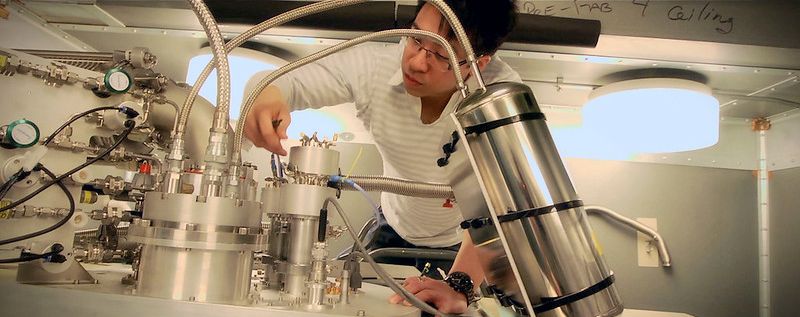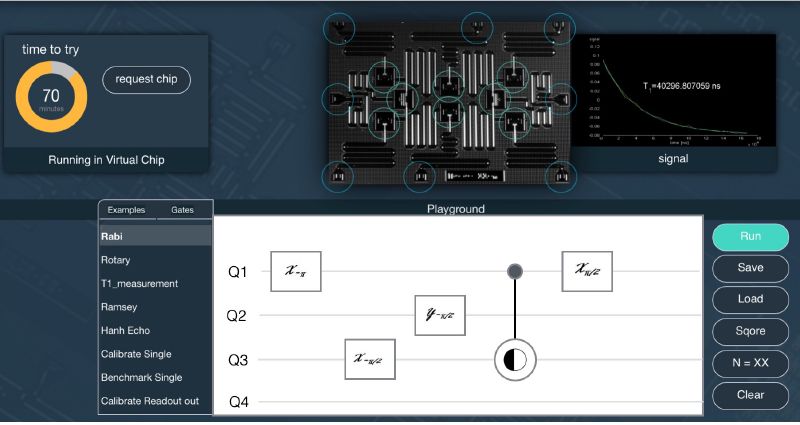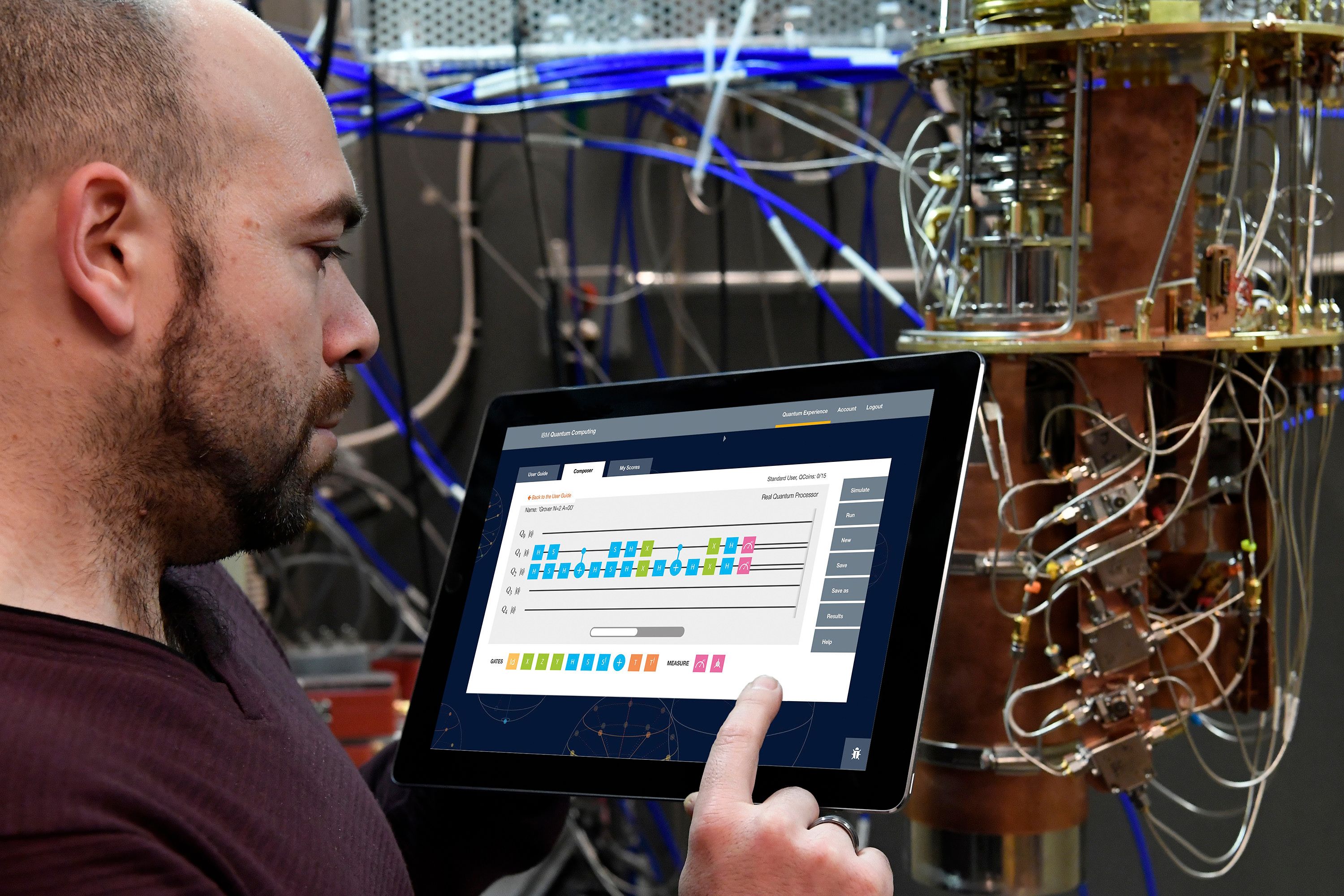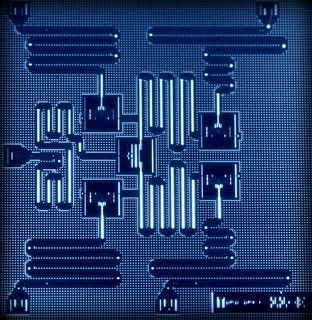Accessing quantum devices wasn’t easy prior to 2016. Theorists had to convince hardware researchers at institutions like IBM to help them realize experiments on custom quantum processors. Given the high quality of IBM’s devices, this work strained the small and already-busy IBM Quantum team — so, team leads Jay Gambetta and Jerry Chow decided to put a quantum processor on the cloud. After all, IBM Quantum team members were already remotely accessing the devices on nights and weekends to run experiments. They got started — but they’d need more and better resources, and to prove that there was actually an audience for a cloud-based quantum computing platform.
The team had the chance to show off the community’s need for a cloud-based quantum processor in December of 2015. Dozens of researchers sat in an auditorium at IBM’s Yorktown Heights campus to discuss the potential of quantum computing hardware at the ThinkQ conference. At the end of his conference presentation, MIT professor Isaac Chuang asked the crowd: Would they use a small-scale, cloud-based IBM quantum processor? Everyone raised their hands.
“It gave us the validation that we had something, and that we could get a lot of people behind it,” said Jerry Chow, now-Director of Quantum Hardware System Development at IBM. More importantly, it proved to IBM overall that this would be a project worth devoting resources to. After witnessing the ThinkQ 2015 audience response, IBM’s then-VP of Science and Technology Dario Gil asked the IBM Quantum team what it would take to deliver the project faster.

In 2012, Dr. Jerry Chow prepares the dilution refrigerator for a quantum experiment. The dilution refrigerator gets down to 15 to 20 millikelvin in order to keep the quantum states very pure and to get the quantum bits into their ground states before any experiments are done. By being this cold, the qubits are less susceptible to any sort of thermal noise and thermal heating that would otherwise bring the qubits out of the ground state. (Credit: IBM)
Now the team would have to make the project a reality — and they’d have to do it in four months.
Five years ago today, the team made history by launching the IBM Quantum Experience, putting the first quantum processor on the IBM Cloud so that anyone could run their own quantum computing experiments. The milestone required months of cross-team and cross-continent collaboration to pull off something that had never been done before — and the impact has been immense. Since then, the team has released a host of groundbreaking research in order to help develop a global quantum computing ecosystem. The IBM Quantum Experience has since evolved, and today IBM runs a suite of cloud-based quantum systems that researchers, businesses, and a vibrant open-source community of developers access with IBM Quantum Composer, IBM Quantum Lab and Qiskit, hoping to learn about how they might use quantum to impact their own computing workflows.
At the end of his conference presentation, MIT professor Isaac Chuang asked the crowd: Would they use small-scale, cloud-based IBM quantum processors? Everyone raised their hands.
Gil paired the team up with recently hired cloud software expert Ismael Faro, who would help them develop a core framework and user interface. The team also brought on external designer Carl De Torres to work on the look of the app.
Faro didn’t have any experience with quantum, at first. But after a few calls, he learned that the team was hoping to highlight a device with five quantum bits, or qubits. Mathematical operations called gates would string these qubits together into circuits. The circuits-and-gates diagrams looked just like music notes on a staff, so the team wanted an interface that would allow users to intuitively “compose” circuits. Faro spent the weekend putting together a prototype webpage and application — and it was exactly what the team wanted.
“I said, ‘I don’t understand it that deeply — but if it works for you, then it’s perfect for me,'” said Faro. Since he said he could have the project ready in four months, Gil, Chow, and Gambetta decided that the hardware would need to go live in four months, as well.

Proof-of-concept mockup of the IBM Quantum Experience from January, 2016. (Credit: Ismael Faro)
Building a front-end application was just one piece of the puzzle, however. The team would need to think about the full experience — how users interact with the app, what features and gates the users could see, how users would send jobs to the backends, how to convert jobs into the quantum assembly language that the quantum hardware could understand, and how to queue up the potentially thousands of jobs on only one device.
Faro hired a software development team of his own — Paco Martin, Fran Cabrera, Jorge Carballo — who got to work, day and night, in order to get the cloud computing infrastructure ready for users to program the device. His team worked closely with Andrew Cross and Lev Bishop, who were developing the OpenQASM quantum assembly language to convert the notation used by theorists, consisting of symbolic quantum gates, into the language of quantum computers, consisting of specially tuned microwave pulses. Meanwhile, other team members worked together to create a guide that would distill quantum computing down for any user who tried to program the device.
The only thing left to prepare was the hardware. Given the timeline, the team decided that rather than build a completely new device, they’d work with the best quantum processor that they already had at their disposal.
Quantum goes online
Superconducting quantum computers consist of a printed circuit board of superconducting electronics, programmed with those microwave pulses. As happens today, these processors sit hooked up to control electronics inside of a bucket-sized dilution refrigerator. The refrigerator ensures that the qubits maintain their superconducting properties and face a minimal amount of thermal noise, or vibrations caused by excess heat. But any disturbance can cause the qubits to decohere — or forget their programmed quantum information — even the day-to-day vibrations from the building itself.
For nearly a decade prior, the team led by IBM Fellow Matthias Steffen studied qubits and qubit interactions, and worked to improve and scale up these superconducting devices. They’d made plenty of advancements, but quantum processors were still in the realm of noisy lab experiments back in early 2016. They were not easy things for physicists to control, let alone allow thousands of people to remotely control.
“Quantum isn’t like a database backend where there’s a lot of standard infrastructure for putting devices online and managing them,” said Bishop, who works on quantum computing theory at IBM. The team would need to improve a device not only so it would be resilient to noise and errors — but also, this piece of advanced physics equipment needed to remain online and in constant operation for most of the time.

IBM Quantum Computing Research Scientist Antonio Córcoles uses the IBM Quantum Experience on a tablet in the IBM Quantum Lab that shows an open dilution refrigerator (Jon Simon/Feature Photo Service for IBM)
Research staff member Antonio Córcoles, too, worked with Cross and Bishop to calibrate the devices such that the qubits reacted properly to inputs and retained their assigned values long enough to perform calculations. His team struggled for weeks to improve the device metrics as time closed in. But they continued forth, applying techniques developed during several years of IARPA-funded research and optimizing the cryogenic wiring configuration for best qubit coherence times and gate speed.
Once the qubits began behaving stably, the researchers needed to ensure that their work was reproducible, that the gates produced the expected output, and then needed to ensure the system automatically calibrated the devices twice daily. The team needed to guarantee the performance of the device for users, and needed to iron out the glitches that seemed to continually pop up, while anticipating any issues introduced by users unfamiliar with the limitations of quantum devices.
Things were getting down to the wire — team members lost plenty of sleep preparing for a smooth launch with a device whose metrics they felt comfortable presenting to the public and to competitors. Even the night before the launch, the pressure was higher than ever. How many people would sign up for the IBM Quantum Experience? What kind of trouble would the hardware face?
“I remember distinctly the night before — at midnight, I was sitting, refreshing my browser waiting for the IBM news release to publish,” said Córcoles.
The IBM Quantum Experience went live on May 4. The five-qubit device boasted metrics better than competitors’, and the first circuit executions started rolling in. The trickle quickly became a flood; 7,000 users registered for the IBM Quantum Experience in the first week, and more than 17,000 users registered by the second.
Releasing a cloud-based quantum computer publicly was the ultimate test. Users introduced interesting new considerations — issues that might have been fixable with a simple hard exit in the lab were a much bigger deal on cloud-based hardware. For example, a piece of third-party lab equipment seemed to cause the experience to freeze every thousand runs or so. So, the team eventually needed to rewrite the equipment’s software with the vendor, said Bishop.

The layout of IBM’s five superconducting quantum bit device. (Credit: IBM)
The following months brought perhaps the most important lessons. The team pored over hundreds of pieces of user feedback and kept track of their own fixes to improve the experience and systematize the process so they could put even more devices online. And while they were patching errors individually in a Slack channel, they worked to find more permanent fixes so that they could go back to developing more hardware, rather than serve as tech support for the expanding processor fleet.
“I think the first release was a very important step,” said Córcoles. “But the magnitude of what we’ve done now,” putting dozens of devices onto the cloud and offering them, many for public use, to developers around the world, “is quite staggering.”
The biggest lessons learned were how to build stable devices, how to bring them online, and how to automate some of the most important experiments — especially device calibration. “Honestly, putting a quantum computer on the cloud requires an entirely different mindset,” explained Gambetta, IBM Fellow and VP of Quantum Computing. “We look at these devices not as lab experiments, but as systems.”
The wider research field has felt the impact of having access to these devices, too.
“As a theorist in the field of quantum computing, one can’t tell the experimental quantum community what experiments to do, so access to cloud-based quantum processors and the experiments one can do with them are very appealing,” said Barbara Terhal, theoretical physicist and professor at TU Delft.
“Cloud-based quantum computers show very concretely what quantum computing is about, including all the limitations which current quantum devices have in terms of numbers of qubits, connectivity and noise. The IBM processors have generated a huge following, any self-respecting quantum research facility or company likes to provide cloud-based quantum processors nowadays.”
Recent IBM quantum progress
Putting a quantum system on the cloud represents many years of progress from IBM Quantum research team — both before and since the milestone. All the while, the team has continued to put out papers with an outsized impact on the quantum computing field overall. For example:
- In 2011, we released a paper demonstrating the impact of external radiation on limiting qubit performance that has allowed the field a new understanding of how to improve our devices.
- In 2015, we demonstrated the [2,0,2] error-correcting code — one of the earliest experimental demonstrations of quantum error detection.
- In 2016, we developed an error mitigation strategy for short-depth quantum circuits; not quite correcting errors, but handling them without additional qubits.
- In 2017, we presented the first experimental demonstration of a quantum computer simulating a molecule larger than hydrogen or helium — lithium hydride — using a six-qubit device.
- In 2018, we proved that an ideal quantum computers will always beat classical computers when tackling shallow circuits, and last year, extended this proof to cover shallow circuits in the presence of noise.
- And just this year, we demonstrated a quantum algorithm with a rigorous and robust speedup when tackling certain elements of supervised machine learning.
But the team has created impact beyond just scientific advances—they’ve built a platform for experiment and discovery. Today, over 325,000 users have registered on the IBM Quantum platform, and at this past APS March Meeting, 46 non-IBM papers ran experiments over the cloud on IBM Quantum devices. Thousands of developers run two billion quantum circuits on IBM Quantum computers daily, now with the help of the open source Qiskit Software Development Kit. And they’re continuing to push forward. Just this past year, IBM Quantum announced its hardware and software roadmap, explaining how they plan to scale devices to 1,121 qubits and beyond, and how to build an open ecosystem around programming and finding useful applications for these devices.
By the numbers
- Number of registered users: 325,000+
- Number of Qiskit downloads: 650,000+
- Number of papers published using IBM Quantum: 700+
- Number of IBM Quantum Network orgs: 140+
- Number of circuits run: 2B+/day
Perhaps most importantly, the IBM Quantum Experience was just the first step of IBM’s broad effort to build a global, diverse, and inclusive quantum computing community. Back in 2018, Liz Durst joined the team in order to build a community centered around quantum computing with Qiskit. With her help, quantum computing is now accessible to a broader audience than ever. By putting a quantum computer on the cloud, the team has encouraged more people to learn quantum through our educational initiatives and to pursue new internship and job opportunities that have opened worldwide. We hope to continue realizing this vision into the future as we develop a robust and open quantum computing ecosystem.
None of this could have been possible without the team putting that first 5-qubit quantum system on the cloud.
“We changed the entire field,” said Chow. “All of the discussions up to that point were about cool experimental demonstrations, But today, when I log into the arXiv, every night I see another paper using an IBM Quantum system to run some experiment. It’s really changed the way that the field does quantum computing research, and how many people can do quantum research by having access to these tools.”
Celebrate five years of IBM Quantum on the cloud by taking part in the next IBM Quantum Challenge, scheduled for May 20, 2021! Learn more here.




